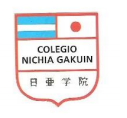Instituto Privado Argentino-Japonés
| Instituto Privado Argentino-Japonés Nichia Gakuin 日亜学院 | |
|---|---|
 | |
 | |
| Address | |
 | |
Yatay 261/Pringles 268 Argentina | |
| Coordinates | 34°36′34″S 58°25′44″W / 34.609494°S 58.42893600000002°W |
| Information | |
| Type | Private school |
| Website | nichiagakuin |
 | |
Instituto Privado Argentino-Japonés (IPAJ), also known as Nichia Gakuin (日亜学院), is a bilingual Spanish-Japanese elementary and middle school in Buenos Aires. It is the only school permitted by the Argentine Ministry of Education to require students to take Japanese,[1] and it is the only bilingual Spanish-Japanese school in Buenos Aires.[2] Its campus is located at Yatay 261 and Pringles 268 (two addresses for the same building) in the Almagro neighbourhood.[3]
Ricardo Braginski of Clarín wrote that the school represented the community of Japanese descent in Buenos Aires.[4]
History
[edit]The origins date from 1922.[2] The Nichia Gakuin school began offering courses in 1927 and the bilingual day school was first established in 1938. Its initial location was Patagones 84.[5] Argentine authorities closed the school in January 1945 upon the Argentine government declaring war against Japan as part of World War II.[6] It reopened in 1947 and took the formal name "Instituto Privado Argentino-Japonés" in 1978. It moved to its current Yatay campus in 1984.[5]
See also
[edit]References
[edit]- (in Japanese) Ashihara, Kyoko (葦原 恭子 Ashihara Kyōko; Associate Professor Global Education Center, University of the Ryukyus). "Current Status and Issues of Japanese Language Education in Argentine : The Case of Instituto Privado Argentino Japones en Buenos Aires Archived 2018-01-23 at the Wayback Machine" (アルゼンチンにおける日本語教育の現状と課題 : ブエノスアイレス日亜学院の事例から (特集 文化共有集団による越境的ネットワークの国際比較研究 : ウチナーンチュとバスク人をめぐって)). Immigration Studies (移民研究) (12), 61–80, 2016–10. Center for Okinawa Migration Studies (沖縄移民研究センター). See profile at Archived 2018-01-23 at the Wayback Machine University of the Ryukyus Repository (琉球大学学術リポジトリ). See profile at CiNii. English abstract available.
Notes
[edit]- ^ Ashihara, p. 80 (PDF p. 21/21), English abstract.
- ^ a b Nogués, Germinal. Buenos Aires, ciudad secreta (Obras Diversas). Penguin Random House Grupo Editorial Argentina, May 1, 2015. ISBN 950075231X, 9789500752312. Google Books PT263: "Misceláneas. En Yatay 261 se halla el único colegio japonés de Buenos Aires, cuyos orígenes se remontan a 1922 y opera como escuela bilingüe."
- ^ Home. Instituto Privado Argentino-Japonés. Retrieved on January 23, 2017. "Yatay 261 / Pringles 268 CABA"
- ^ Braginski, Ricardo (2017-11-10). "Día de la Diversidad Cultural: una escuela judía y otra japonesa, unidas por una historia en común". Clarín. Retrieved 2018-01-23.
- ^ a b "Artículos Nichia Gakuin Archived 2018-01-23 at the Wayback Machine." Instituto Privado Argentino-Japonés. Retrieved on January 23, 2017.
- ^ Masterson, Daniel M. and Sayaka Funada-Classen. The Japanese in Latin America. University of Illinois Press, 2004. ISBN 0252071441, 9780252071447. p. 146.
Further reading
[edit]- Nichia gakuin 70 años (日亜学院創立70周年記念誌) or Instituto Privado Argentino Japonés, 1927-1997. Instituto Privado Argentino-Japonés. 1997 Printing. See profile at CiNii.
- Sekiguchi, Shinji (関口伸治). バイリンガル校としての日亜学院 Buenos dias Buenos Aires. MarucciPress (マルッチ・プレス), 1992. See profile at CiNii.
External links
[edit]- Instituto Privado Argentino-Japonés (in Spanish)
